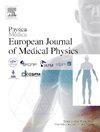Predicting radiotoxic effects after BNCT for brain cancer using a novel dose calculation model
IF 2.7
3区 医学
Q1 RADIOLOGY, NUCLEAR MEDICINE & MEDICAL IMAGING
Physica Medica-European Journal of Medical Physics
Pub Date : 2024-11-08
DOI:10.1016/j.ejmp.2024.104840
引用次数: 0
Abstract
Purpose:
The normal brain is an important dose-limiting organ for brain cancer patients undergoing radiotherapy. This study aims to develop a model to calculate photon isoeffective doses () to normal brain that can explain the incidence of grade 2 or higher somnolence syndrome (SS2) after Boron Neutron Capture Therapy (BNCT).
Methods:
A model was constructed to find the reference photon dose that equals the Normal Tissue Complication Probability (NTCP) of the absorbed dose from BNCT. Limb paralysis rates from the rat spinal cord model exposed to conventional or BNCT irradiation were used to determine model parameters. NTCP expressions for both irradiations were constructed based on Lyman’s model accordingly. values were calculated for BNCT treatments performed in Finland and USA. An equivalent uniform dose (EUD) based on peak and average whole-brain doses and treatment fields was also introduced. Combining and EUD models, a dose–response curve for SS2 in BNCT patients was constructed and compared to conventional radiotherapy outcomes.
Results:
The model reveals higher than expected photon-equivalent doses in the brain, indicating the need to modify standard dose calculation methods. Neither peak dose nor average whole-brain dose alone predicts SS2 development. However, the dose–response curve derived from combining and EUD models effectively explains the incidence of SS2 after BNCT.
Conclusions:
The introduced and EUD models predict the incidence of somnolence syndrome after BNCT. The first dose–response relationship for SS2 derived entirely from brain tumour patients treated with BNCT, consistent with photon radiotherapy responses, is presented.
利用新型剂量计算模型预测脑癌 BNCT 治疗后的放射性毒性效应。
目的:正常脑部是脑癌患者接受放射治疗的重要剂量限制器官。本研究旨在建立一个模型来计算正常脑部的光子等效剂量(DIsoE),以解释硼中子俘获疗法(BNCT)后2级或2级以上嗜睡综合征(SS⩾2)的发生率:方法:构建了一个 DIsoE 模型,以找到与 BNCT 吸收剂量的正常组织并发症概率 (NTCP) 相等的参考光子剂量。大鼠脊髓模型接受常规或 BNCT 照射后的肢体瘫痪率被用来确定模型参数。根据莱曼模型构建了两种辐照的 NTCP 表达式。计算了在芬兰和美国进行的 BNCT 治疗的 DIsoE 值。还引入了基于峰值和平均全脑剂量及治疗野的等效均匀剂量(EUD)。结合 DIsoE 和 EUD 模型,构建了 BNCT 患者 SS⩾2 的剂量反应曲线,并与传统放疗结果进行了比较:结果:DIsoE 模型显示大脑中的光子当量剂量高于预期,表明需要修改标准剂量计算方法。无论是峰值剂量还是全脑平均剂量,都不能单独预测 SS⩾2 的发展。然而,结合 DIsoE 和 EUD 模型得出的剂量反应曲线能有效解释 BNCT 后 SS⩾2 的发病率:结论:引入的 DIsoE 和 EUD 模型可预测 BNCT 后嗜睡综合征的发病率。结论:引入的 DIsoE 和 EUD 模型可预测 BNCT 后嗜睡综合征的发病率,首次提出了完全来自接受 BNCT 治疗的脑肿瘤患者的 SS⩾2 剂量-反应关系,与光子放疗反应一致。
本文章由计算机程序翻译,如有差异,请以英文原文为准。
求助全文
约1分钟内获得全文
求助全文
来源期刊
CiteScore
6.80
自引率
14.70%
发文量
493
审稿时长
78 days
期刊介绍:
Physica Medica, European Journal of Medical Physics, publishing with Elsevier from 2007, provides an international forum for research and reviews on the following main topics:
Medical Imaging
Radiation Therapy
Radiation Protection
Measuring Systems and Signal Processing
Education and training in Medical Physics
Professional issues in Medical Physics.

 求助内容:
求助内容: 应助结果提醒方式:
应助结果提醒方式:


